In the last few weeks, I saw several incidents and articles that led me to think about why I blog. First there was the whole Food52 Piglet controversy between two popular bloggers, Mimi Thorrison and Adam Roberts. From that hot mess came several wonderful nuanced and articulate articles from Eater, Lottie + Doof, and Design Sponge that offered differing perspectives on the incident, and each said a lot about the world of blogging and food media.
This post kind of came from me thinking about and digesting all of that. And let me be up front: It’s long and a tad controversial. For a while, I even struggled whether to publish it in the first place. But below are some thoughts about my blog, blogging in general, and the direction I worry it’s headed in the long run (and if you want to skip my rambling and head straight to the recipe, I promise I won’t be offended at all!):
So, first some background: I started this blog back in 2011 as a way to keep up with friends and family, as well as distract myself from a job I hated. Back in 2011, even though it wasn’t all that long ago, Blog Land was an entirely different landscape. Pinterest was just getting started and only accepting new users via email. People still used Instagram in the way they use their personal Facebook profiles today; that is, folks only followed people they knew in real life as Instagram’s content was primarily blurry photos with overwrought filters.
Back in the day, the only way to get your food blog noticed immediately was submitting to content aggregation sites like Foodgawker and Tastespotting. Unlike Pinterest and Instagram, there was actually some sort of quality control — you submitted your picture, and you waited with baited breath to see if your recipe would be published on the site. In the beginning, especially when I was just starting to figure out my DSLR camera, I got a lot of rejections. Rejections often came back with blunt feedback: bad composition, harsh lighting, white balance issues, etc. That feedback, while harsh, was really helpful in helping me figure out how to take good photos! I still remember the butterflies in my stomach when Foodgawker finally accepted and published one of my pictures, a not-that-great, slightly overexposed and underfocused picture of this hazelnut crepe cake (whose pictures are… well…eek!). But still. If I had to point to one thing that put my blog on the map and bring in, you know, readers who weren’t my immediate friends and family, I’d probably have to credit Foodgawker and that picture, which eventually got republished by The Huffington Post.
And this is where my memory starts to get hazy. Because it was around here, sometime between my multiple, frustrated attempts to get published on these sites, that I got bit by The Bug. You know, the feeling of awe that people you don’t know are reading your work and interested in what you are saying; the feeling that your blog could be something MORE… a fully fledged cookbook, a full time job with a steady paycheck, and a stream of sponsorship opportunities with cool companies. You name it, the sky was the limit. Blogging was a new, uncharted world full of financial opportunity and internet fame that I — or anyone, really — could easily tap into. That was The Bug.
I’m not going to lie. I definitely got suckered into all that, especially after Saveur Magazine shortlisted me as one of the Best Baking & Desserts Blogs and the press mentions, sponsorships, and free SWAG came rolling in. I did sponsored posts for the money and wrote nice things about products I was just “meh” on but felt guilty because I’d gotten it for free. These days, I’m extremely picky about the people, companies, and products that I work with. Because after a while of saying “yes” to everything, I started to realize that it just wasn’t my jam. The extra money was nice, sure, but every sponsored post took me further away from why I was blogging in the first place: learning how to cook new baked goods and play with different ingredients. And of course, there was less talking about my life and the things I ate with friends who were far away — instead, I was talking about products and events I attended in a weird overly-smiley, way-too-shilly way. It wasn’t sincere or authentic.
And then there was a whole other gross thing I caught myself doing: pandering. What does that mean, exactly? One of my blogger friends, Kathryn, wrote a thoughtful, articulate post about baking for the sake of blogging that’s worth checking out. As for myself, as recently as a few weeks ago, I noticed that my Instagram follower count would decline as I posted lots of photos of my trip to Singapore and the Philippines. I realized that the majority of my followers only followed me for my dessert pics, and my dessert pics alone. Why else would a picture of a pie recipe of mine have twice as many likes as a picture of some cool architecture in Singapore or dropdead gorgeous ocean views in the Philippines? My initial reaction to the fluctuation was, Oh, shoot! Gotta keep my Instagram followers high; I’ll scale back on my trip pictures and just keep posting pictures of sweets. And I actually freaking restrained myself, holding back photos of mountains and oceans in order not to annoy anybody!
But later, as I was standing watching my old boss dance around in the best Darth Vader costume I have ever seen (complete with a glowing light saber), I realized that there was no way I could NOT take a photo of this for my Instagram feed. There were a handful of old friends and coworkers who I know would just DIE with laughter seeing the photo. It seemed ridiculous to text them all individually, especially since they all followed me on Instagram. Why was I censoring myself, restraining myself from posting and sharing pictures of experiences that I was enjoying? Because a bunch of anonymous followers who I didn’t know personally were unfollowing me?!! Like… really???
Ugh.
I guess what I’m trying to say is, that in the last three and a half years of blogging, I’ve found myself too easily caught up in the “fame and fortune” side of things. And whenever I am in that funk, I always get really depressed and down on my blog — beating myself up for not making more money, not having as many followers, not being re-nominated for that award, etc. And I hate that. Because it’s not why I started blogging in the first place, and perhaps more importantly, it’s not why I continue to blog, and certainly not what I love about it at ALL. But it’s incredibly easy to forget, and I have to take a step back and remind myself of that every so often.
My big concern, however, is that blogging appears to be moving in the opposite direction, especially with the turn of Instagram and Pinterest as legitimate growth tools. It’s a lot easier to share the pretty pictures of your recipes on either medium, and watch the likes, hearts, and ultimately, pageviews to your blog roll in as algorithms serve it to people around the world. It’s much easier to amass a big following fast, as long as you have a decent eye for what’s hot right now and use the right hashtags. The Bug is easier to catch more than ever, as folks become famous practically overnight with one Pin or regram.
Ultimately, there’s nothing wrong with blogging to become rich and famous, the chance to break into a new industry, whatever. Blogging deserves to be recognized as a perfectly legitimate career (we all certainly work hard enough on our blogs for that to continue being unrecognized), and it’s well on its way to becoming one. But I just hope that we also don’t lose sincere, authentic, and heartfelt content in the process. Because if everybody’s trying to get big all the time, everybody’s cooking and presenting recipes that they know are popular, taking and styling photos that are on-trend and everybody else will like… right? Which is… fine. But also, not really.
Because it’s like what Tim was saying in his post: we need less pandering, especially the kind that I’ve been guilty of in the past. That is, a little less blogging for the sake of blogging, press mentions, likes, hearts, and much less of that self-censorship that prevents us from posting the content that we actually want to. We need bloggers who are unafraid to bring new criticisms, ideas, and perspectives to the table. And certainly, we need more bloggers who are unafraid to lose followers while doing so.
So post that picture that has nothing to do with food, or publish that recipe that you know is a little bit off-the-rails.
I promise that I won’t unfollow you.
On that note, after emotionally sorting all my feels, I just wanted to bake something that was pretty, tasty, and time consuming enough to be therapeutic… like this pomegranate citrus meringue cake. Why pomegranate? I’ve been drooling over the pink buttercream cakes on Pinterest lately, but since I’m a hater of artificial food coloring, decided to try and find an ingredient that would provide natural color instead. Pomegranate won the fight (though beet, hibiscus, and red wine (!!!) came close), giving the buttercream a wonderful pale pink tint. From there, lemon curd and crunchy meringue crumbles seemed to pair naturally with the subtle fruit flavor. Enjoy!
Some baker’s notes:
-
- This recipe has a lot of individual components to it: meringues, lemon curd, cake and frosting. I ended up using store bought meringues because I ran out of time, but my Christmas e-book from a few years ago contains my go-to recipe for vanilla meringues. If you’re making everything from scratch, I suggest making the meringues first, then the lemon curd (which can be refrigerated up to 1 month), then the cakes and finally the frosting.
-
- This recipe actually makes a three-layer cake; I baked mine in three 6-inch pans, divided two of the cakes in half to create four layers and froze one layer for a later recipe that I’m working on. I’ve included the instructions for three 8-inch pans, so don’t be confused if your cake doesn’t look exactly like mine.
-
- For this recipe, I tried out a neat trick learned from a new cookbook I recently bought: Decorated: Sublimely Crafted Cakes for Every Occasion by April Carter, the extremely talented blogger behind Rhubarb and Rose. In the book, April instructs you to fill cakes with jam by first piping a buttercream border around the edge of the cake to create a “well” for the jam. I used this method (seen in the gif above) to trap in my lemon curd and meringue crumbles.
- The cake is best the day it’s made — the meringue crumbles will loose their crunch fast, especially when sandwiched between cake and lemon curd.
Get the Recipe: Pomegranate Citrus Meringue Cake
Ingredients
For the Lemon Curd
(makes around 1 cup, enough for one cake)
- 1/2 cup granulated sugar
- 1/4 cup freshly squeezed lemon juice
- zest from 1 lemon
- 4 large egg yolks
- 1/4 cup (1/2 stick) unsalted butter, cut into 1-inch cubes
For the Vanilla Cake
- 4 large eggs
- 2 large egg yolks
- 1 tablespoon pure vanilla extract
- 1 1/4 cups buttermilk, divided into 1/4 cup and 1 cup portions
- 3 cups cake flour
- 2 cups granulated sugar
- 4 1/2 teaspoons baking powder
- 1/2 teaspoon kosher salt
- 1 cup (2 sticks) unsalted butter, at room temperature
For the Pomegranate Buttercream Frosting & Meringue Filling
(makes enough to frost one cake)
- 4 cups confectioner's sugar, sifted
- 10 tablespoons unsalted butter, at room temperature
- a pinch of salt
- 2 tablespoons whole milk
- 2 tablespoons 100% pure pomegranate juice (no sugar or other sweeteners added)
Assembly
- 1 cup crushed meringues
- 1/4 cup pomegranate seeds
Equipment
- a candy thermometer
Instructions
For the Lemon Curd
- In a heatproof glass bowl, whisk together 1/2 cup granulated sugar, 1/4 cup freshly squeezed lemon juice, zest from 1 lemon, and 4 large egg yolks. Set the bowl over a pot of simmering water over medium heat to make a double boiler, making sure that the bottom of the bowl isn’t touching the water. Whisk occasionally, cooking the mixture until it thickens considerably and a candy thermometer placed in the middle of the mixture reads 172 degrees (F).
- Remove the bowl containing the curd from the pan. Place on a wire rack and allow to cool until a candy thermometer placed in the middle of the mixture reads 140 degrees (F).
- When the mixture has cooled to 140 degrees, whisk in a couple of unsalted butter cubes from your 1/4 cup portion. Continue whisking until the butter cubes are completely incorporated, and then add another couple cubes until you finish your 1/4 cup portion. Place plastic wrap directly on the surface of the curd to prevent a skin from forming and refrigerate until well chilled before using to assemble and fill the cake.
For the Vanilla Cake
- Center a rack in the oven and preheat to 350 (F). Prepare three 8-inch round cake pans by spraying generously with cooking spray and lining the bottoms of each with parchment paper circles. Spray the parchment paper circles with cooking spray as well.
- In a liquid measuring cup, whisk together 4 large eggs, 2 egg yolks, 1 tablespoon pure vanilla extract and 1/4 cup buttermilk. Set aside.
- In the bowl of a freestanding electric mixer fitted with a paddle attachment, combine 3 cups cake flour, 2 cups granulated sugar, 4 1/2 teaspoons baking powder, and 1/2 teaspoon salt. Beat on low speed for 1 minute or until well combined. With the mixer on its lowest setting, add 1 cup unsalted butter and the remaining 1 cup buttermilk. Raise the mixer speed to medium and beat until light and fluffy, about 2 minutes.
- After 2 minutes, reduce the mixer speed back down to its lowest setting. Add the egg mixture (from the 2nd step) in 3 additions, adding the next addition only when the previous has been fully incorporated into the mixture. Once all the egg mixture has been added, scrape down the sides of the bowl and beat on low speed for 1 more minute and no more — be careful not to overmix or you’ll end up with a dense, tough cake and I’ll cry for you!
- Divide the batter evenly between the three prepared cake pans. Bake in the preheated oven for 30 to 35 minutes, or until a skewer inserted into the center of each cake comes out clean and the top of each cake bounces back when gently poked. Allow the layers to cool in the pans on wire racks for 20 minutes, before turning out onto the wire racks to cool completely before assembling and frosting.
For the Pomegranate Buttercream Frosting
- In the bowl of a freestanding electric mixer fitted with a paddle attachment, combine 4 cups confectioner's sugar, 10 tablespoons unsalted butter, and a pinch of salt. Beat on medium-low speed until the mixture comes together and the butter is fully incorporated throughout the sugar.
- Reduce the mixer to its lowest speed. Combine 2 tablespoons whole milk and 2 tablespoons pomegranate juice in a separate, small bowl and add to the butter mixture a couple teaspoons at a time. Once all the liquid has been incorporated, turn the mixer up to high speed. Continue beating until the frosting is light and fluffy, at least 5 minutes. The longer the frosting is beaten, the fluffier and lighter it becomes. If it is too pale for your liking, add another 1/2 teaspoon of pomegranate juice. But be careful not to add too much, or your frosting will be too liquidy! Add up to 1 1/2 teaspoons more of pomegranate juice max.
Assembly
- Transfer about 1 cup of pomegranate buttercream frosting to a piping bag fitted with a large plain icing tip (or a Ziploc bag with a corner cut off). Pipe a ring around the outer edges of your bottom cake layer, creating a “border”. Learn from my mistakes and be generous with your frosting — you should use around 1/2 cup of frosting for one border. The more you use, the prettier it will look when you slice the cake.
- Use an offset spatula or the back of a spoon to spread 1/2 cup lemon curd in the interior of the buttercream border (see gif above for clarification), meeting the piped line of the border.
- Use your fingers to evenly sprinkle 1/3 cup crushed meringues over the lemon curd.
- Place the next layer on top and press down gently to make sure that the filling is sealed in all the way around. Repeat steps 2 and 3, and nestle the final cake layer on top.
- At this point, use your remaining buttercream to frost the cake in its entirety. Sprinkle the frosted cake with the remaining 1/3 cup of crushed meringues and 1/4 cup pomegranate seeds. Serve immediately.

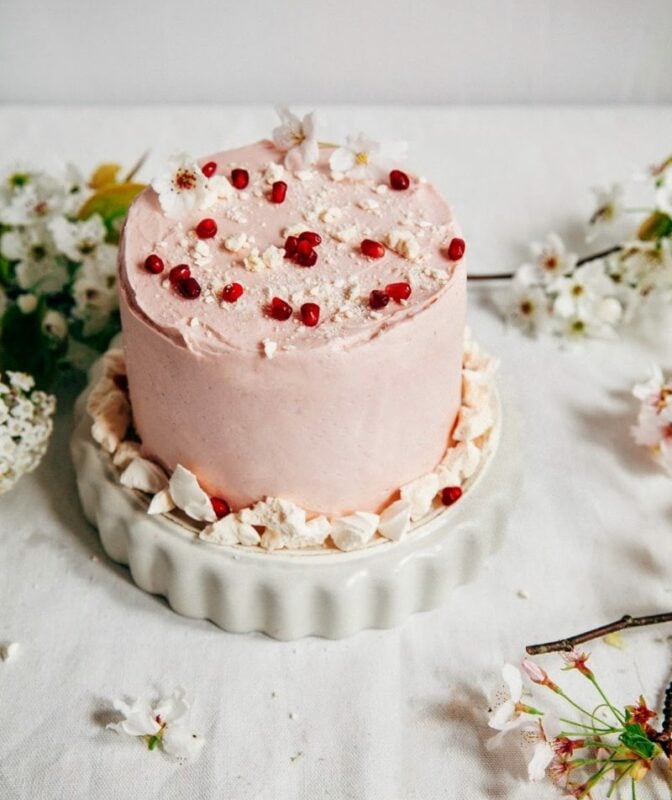

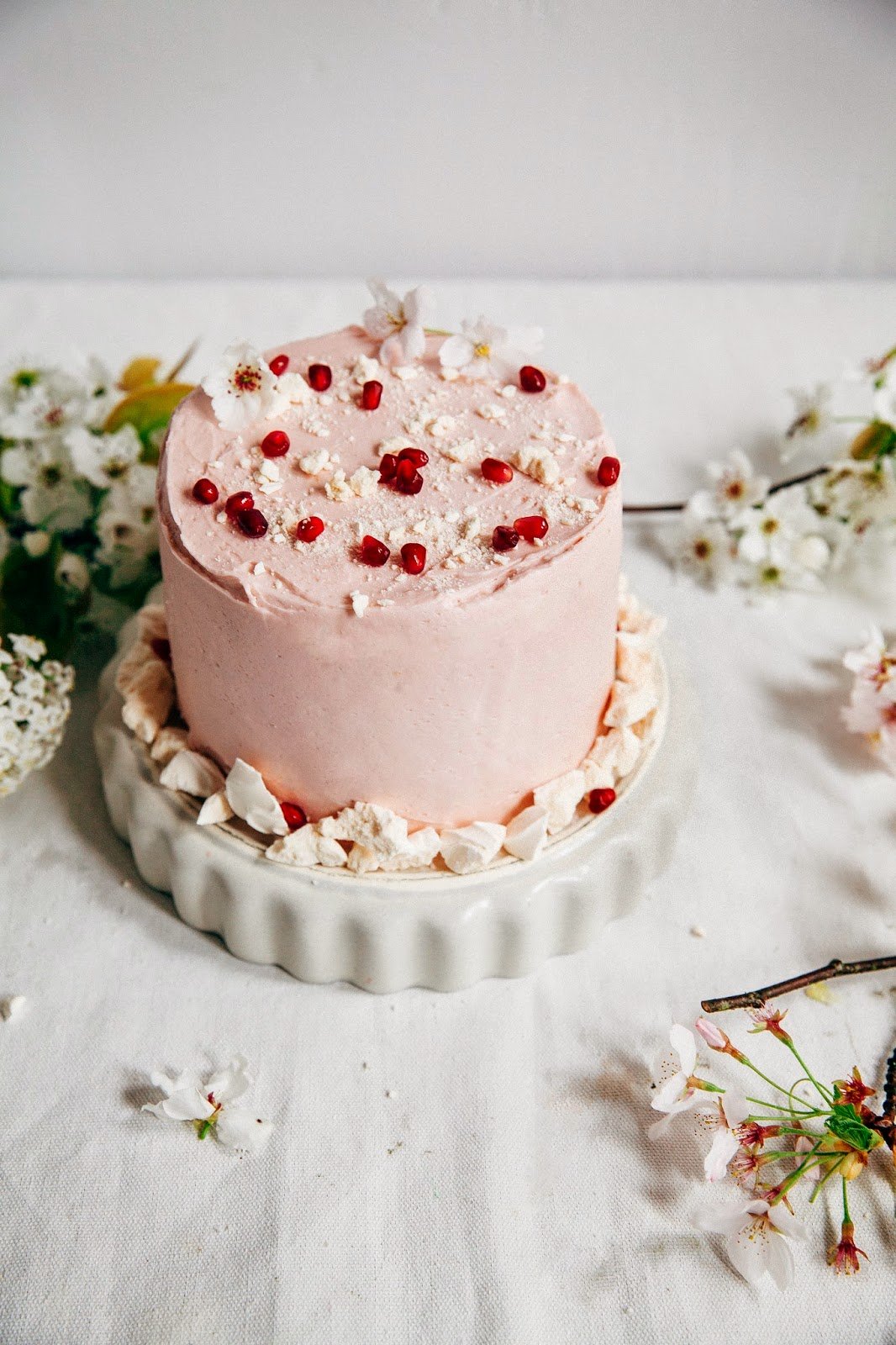
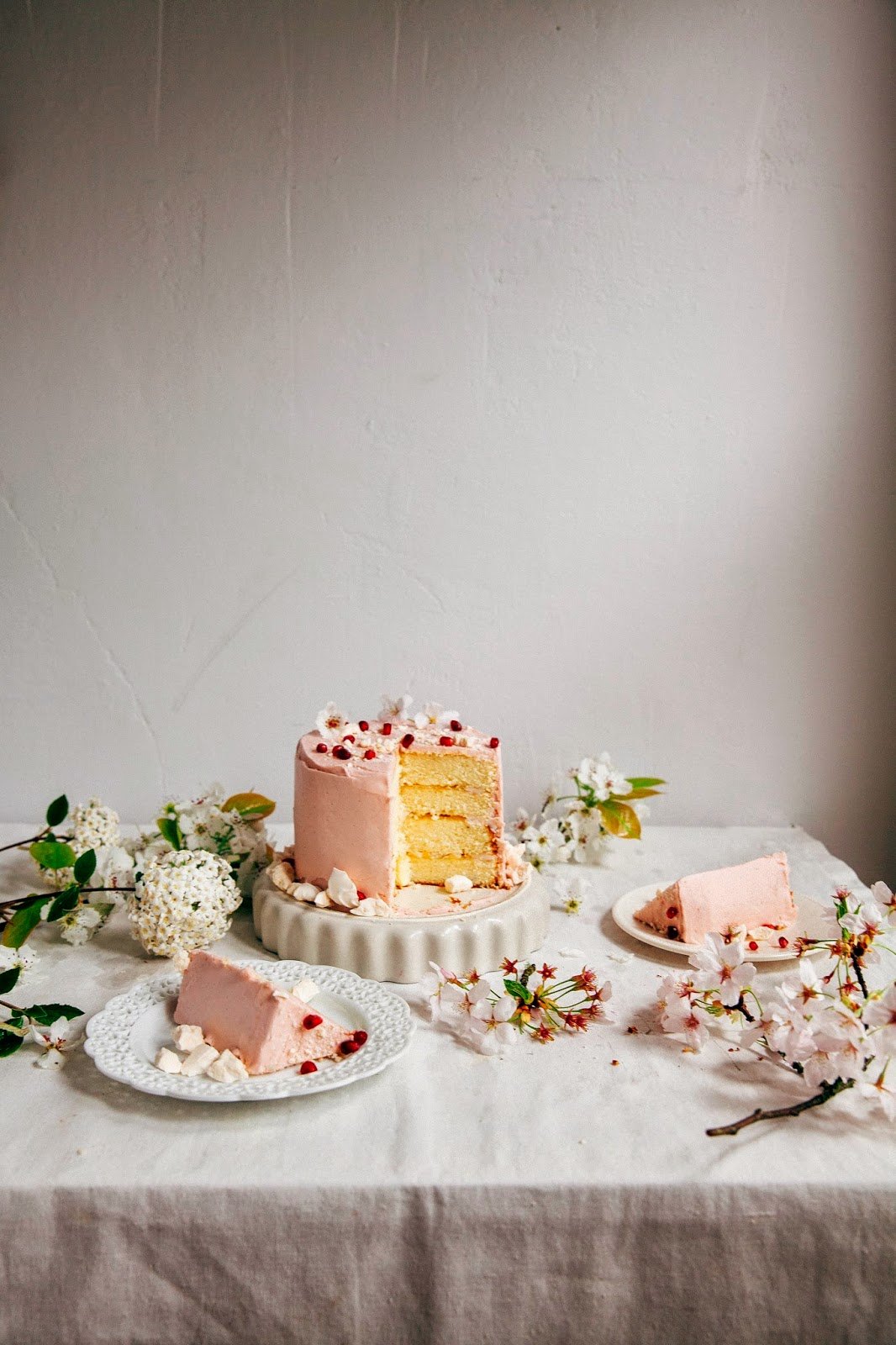
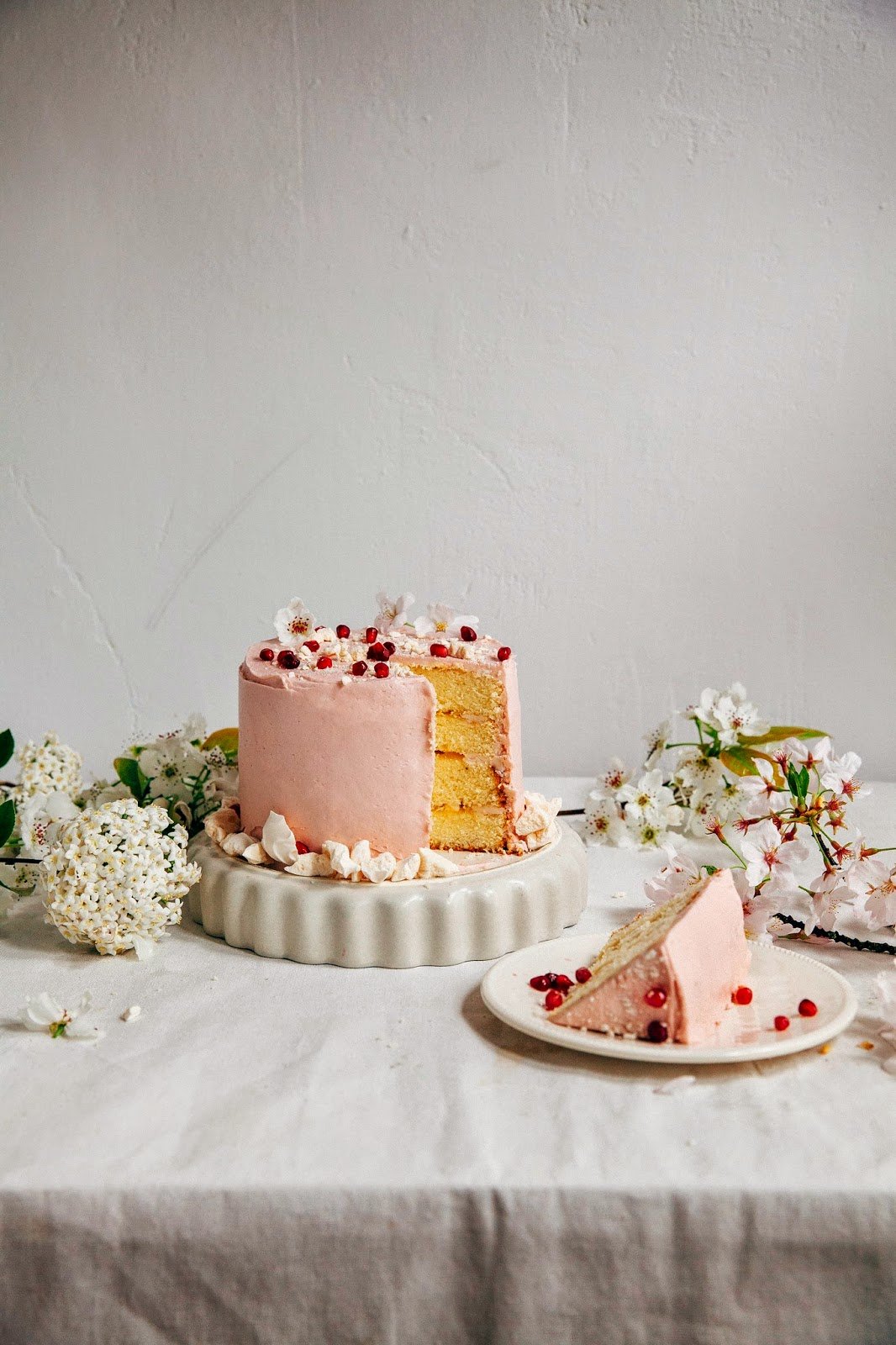
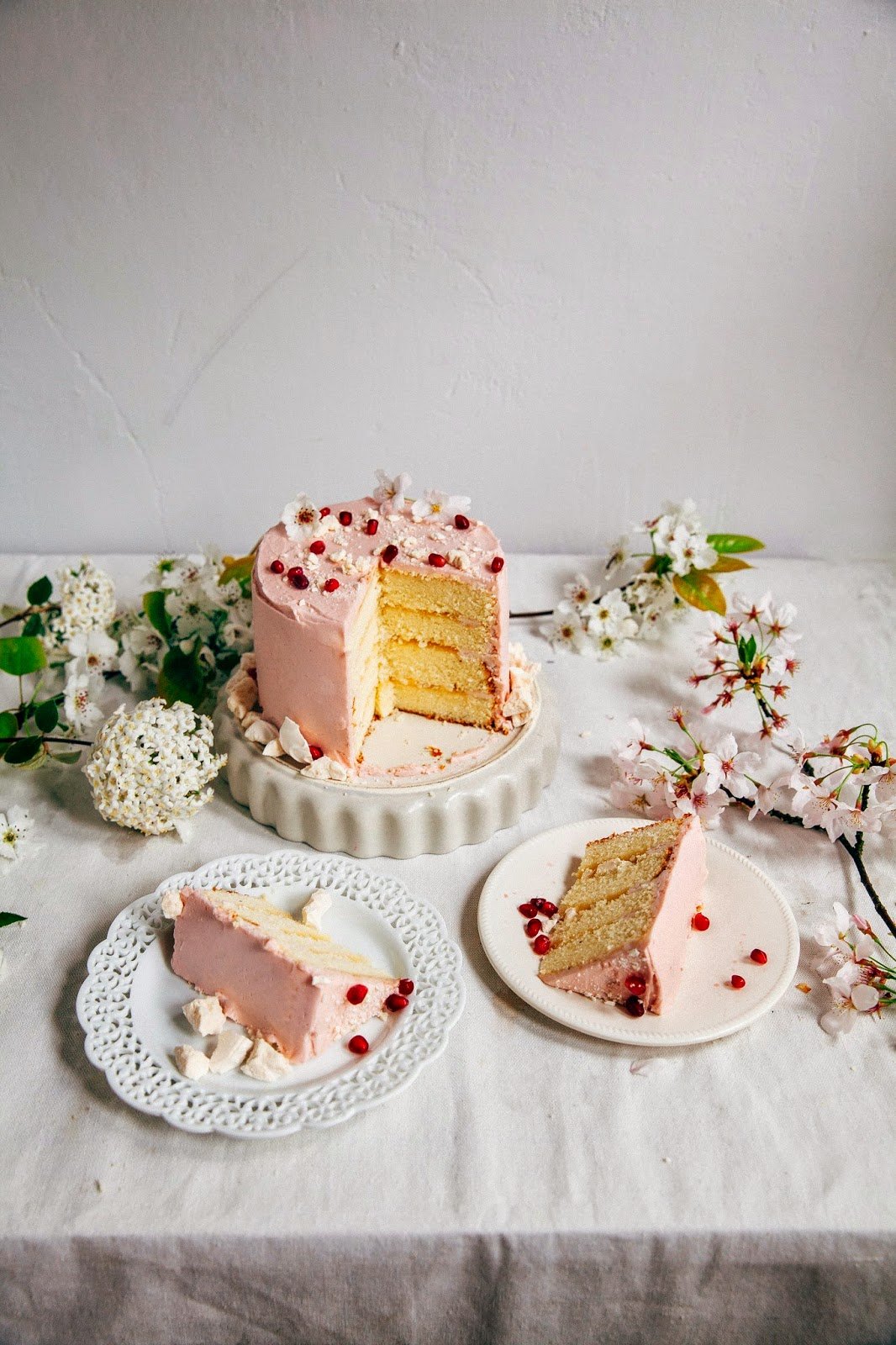
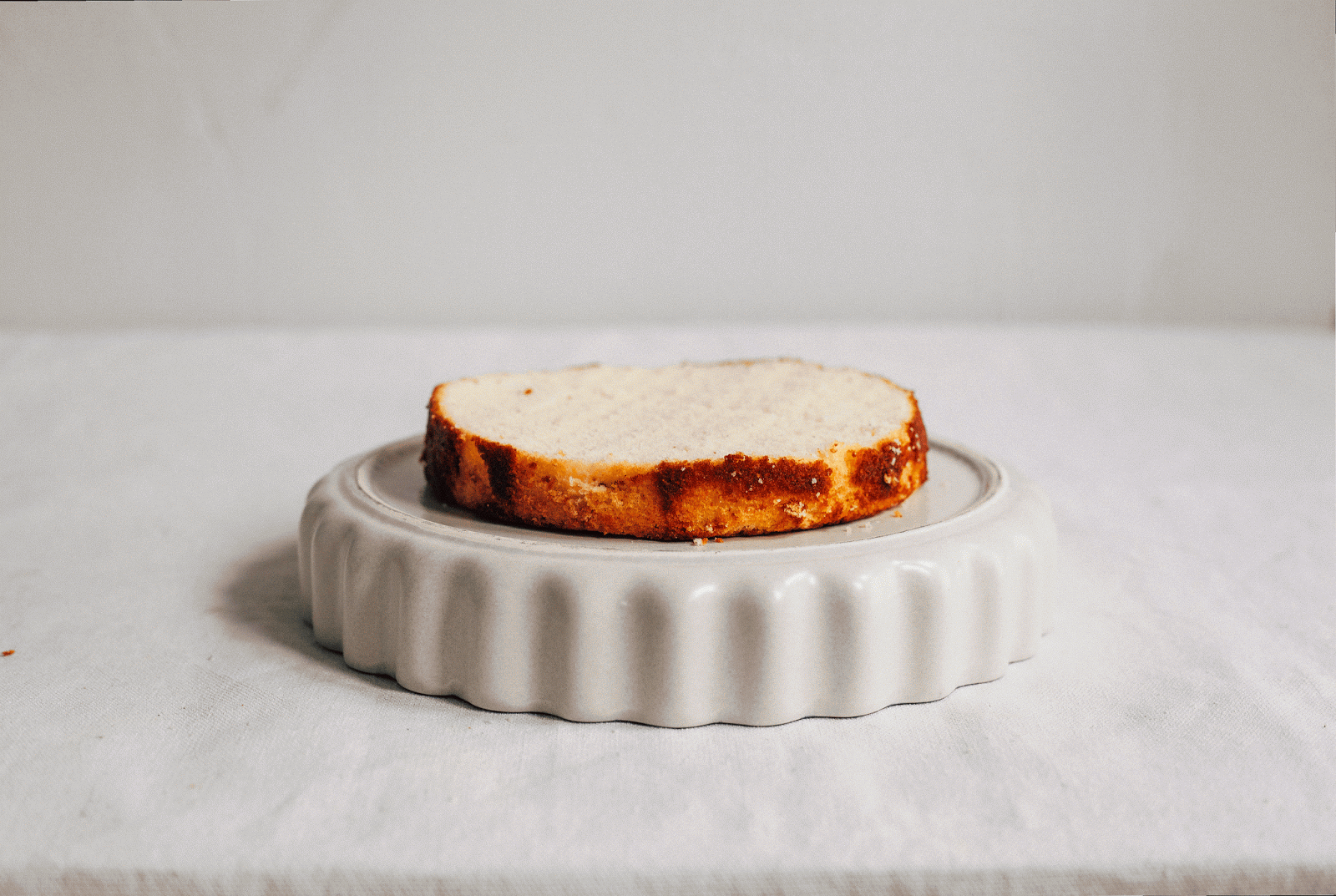

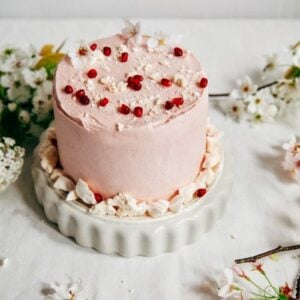

Ditto, Caroline. All the reasons you listed above = all the reasons why I'm still in the game. XOXO
Yeah, I agree with you. I'm all about the cookbooks that are about, you know, food. The whole Piglet thing was out of control though…
Thank you, Maria! xoxo
Hi there, I used this recipe but used 3x 8-inch cake pans instead of the 2x 9-inch cake pans.
Using the same recipe above, but with an additional half of everything? I would add another 1/4 teaspoon of espresso powder.
Hi Kimberley!
1) Thank you!
2) I also read the Piglet review as tongue in cheek — I thought some of Adam's comments were cheap, sure, but I was surprised at how quickly it BLEW up. I'm also surprised at the controversy!!!
3) Word. Let's just do what we want, when we want 😉
I think your point about "being" successful and "appearing" successful is a really important one. If you're sacrificing good work just to "appear" successful, what's the point, right? Like you, I just want to do my baking and photo stuff to the best of my ability 😉
Can't wait to check out your calligraphy!
lol, panda-ing.
Lovely write-up! Great insights and I thoroughly enjoyed reading your thoughts as well as drooling over your cake as I read 🙂 That last gif is crazy awesom!
Your post explains exactly why I stopped I found myself writing in a "fake blogger voice" that just wasn't me.I would get obsessed with my stats and number of followers, to the point where if a new post didn't do well I felt like I had somehow failed.
I've been thinking about getting back into blogging recently, but more as a creative outlet for myself than as a tool for fame and fortune. I hesitate only because the "likes" are very addictive and it's hard to not to write for them.
Thank you for your thoughtful words on blogging. Funny, I follow you on Instagram and was over the moon when I saw your travel photos because they were so incredible! Anytime a blogger does a travel post, I always love seeing the photos and reading about what they ate.
As for content in a post, I love to see gorgeous photos of desserts (and your photos are incredible for this post!!!!!), but I am not just interested in the superficial. That is why I take the time to read every post instead of just looking at the pictures. I like to get to the heart of the post. Also, anything I have ever made from your blog has been INCREDIBLE, so I can tell you put your heart into it.
I am struggling with my blog because I am not so much interested in fame as I am in recognition from other bloggers, and it is hard to break into the circle! It makes me want to work harder though, as there is always room for improvement. In my opinion, I had to check my vanity at the door when I started blogging, because I have received a lot of rejection.
Your pictures of your beautiful cake drew me in, but your words sucked me in. I left a job I hated a year ago to focus on growing my blog. However, it has not been as successful for me so I recently made the decision to start my own business and to go back to blogging as a hobby. Thank you for your message in this post.
Michelle – I discovered your blog last week via AT/ The Kitchn. And at first, I just wanted to drool over your gorgeous new kitchen (congrats!) and take notes for my own upcoming renno. But after reading a bunch of old posts, I had to add your blog to my regular reads. Not so much for the baking, but more for posts like this….honest, authentic thoughts on life and blogging….it's really a rare and precious thing to find online. Don't stop!
I don't even know how came to your blog…I've been traveling from blog to blog and end up here. What a treat! I've loved your post, so sincere, so honest. I'm not a blogger but I think e can all relate what you said and feel with some part of our lifes. Thank you so much for sharing!
Michelle, you have absolutely outdone yourself! Beautiful cake and such wonderful words as well. I sometimes get dragged into the 'competitive' mindset and it's so important to remind myself to be supportive instead! Thank you!
Beautiful post, Michelle. Thanks so much for sharing this! I appreciate your honesty and perspective, two things that always rings true in your writing. Also, slightly freaking out about this cake and its layers – so pretty!
Thanks for sharing your thoughts about blogging! I definitely agree: no job should be done solely for the money or fame. Wouldn't you rather be poor and happy than rich and miserable? 🙂
I love your photography! This cake looks delicious 🙂
Thanks for writing (and posting!) these truthful words. I've ben struggling with this exact thing and my blog isn't even one year old yet. I pledge for more content we truly love over meticulously researched content we only do halfheartedly. I had a massive drop in pageviews since I started blogging about what I really want but who cares, at least I'm not dreading blogging anymore!
I can't thank you enough for this post. I feel like you read my mind! I've been thinking about the direction of my own blog for the past couple weeks and have been very torn. Your words have given me a lot more food for thought! I like monetizing so I can afford ingredients and camera swag, but I always feel a little dirty if I do a sponsored post where I'm just not crazy about the product or post concept.
I also had a looong discussion with my sister about self-censorship on my blog out of fear of losing readers or offending people, being authentic and human, etc. I also worry about posting too many photos of my son on Instagram, but… he's goddamn adorable, so I'm trying to worry about it less. I'm not going to miss documenting these moments and sharing with family over blog followers. I was actually in the process of drafting a post about my own thoughts on this subject when I took a break to catch up on blogs and saw this!
And, as usual, this cake is incredibly gorgeous and sounds like a fantastic recipe. <3
Dear Michelle,
I've been reading your blog for a long, long time. Since 2012, actually. And I've looked up to your simple, beautiful photography, delicious food and artful writing. Thank you for being so honest on this post.
I'm commenting now since I'm a new food blogger, and I don't think I've ever dreamed as big as getting tons of sponsorships, traffic and collaborations. But now that I'm reading this, I'll try to prepare for "The Bug". I have some questions I really hope you could answer.
1. Why did you write great reviews about products you only thought were "meh"? Was it guilt, or hope for more sponsorships?
2. If I was writing a review about a paid meal at a restaurant but thought it was just ok, should I let the owner know? OR if I think it's terrible, should I let the owner know I'll be releasing a bad review?
3. You say that you were getting caught in beating yourself up over not enough new followers or getting renominated, when that wasn't what you started blogging or continue blogging for anyway. So what DO you do it for? Pure love of baking and sharing?
4. You say that you bake this cake that's long enough to prepare to be therapeutic. What else do you do that relaxes you? (eg. education, volunteering, planting trees, hiking, traveling, sowing, etc?)
Thank you for your time, it really means a lot to me.
A huge fan,
Moe (moebakingcomics.wordpress.com)
Hey, thank you for taking the time to write such thoughtful questions! Do you have an email address I could reach you at? I'm happy to discuss this all over email!
oops, rereading the post and found answer to #3: "learning how to cook new baked goods and play with different ingredients."
My bad! 😛
Thank you for these thoughts! Inspiring and grounding.
I love the honesty in this post. As a new blogger watching my counts go up or down, I get easily encouraged or discouraged. I keep reminding myself why I am blogging.
Kari
http://www.sweetteasweetie.com
Dear Michelle, tk you for the lovely blog and the open mind words. I am started my blog1 year and a half ago and am doing as a hobby. But of course be able to earn money with it would be really good. But in the end, nothing can pay the joy i have by posting something that i love. So your words just encorage me to keep that way. Cheers from Brazil!
Michelle,
Thank you so much for sharing what I've been thinking all along. My blog is still a baby, relatively speaking, but I refuse to compromise on the actual CONTENT just to gain followers. I've never been a fan of blogs that solely speak about JUST what they are baking or cooking. I love connecting stories to my food, or sharing tips and tricks that will make people better bakers, not just over-describe what they see in front of them. I mean, that's why we all love to cook and bake, right? Because it not only allows us to make and eat delicious food, but it allows us to share it with others!
After reading your post, I am confident that I should keep doing what I'm doing. The people who want the content will appreciate it the most, and those are the kinds of people that I want to read my work!
You rock,
Blayre [letherbakecakeblog.com]